Well, that's one way of staying warm: Torchbearers light up Lewes in anti-papist parade on the coldest Guy Fawkes Night in 14 years
-
•Thousands line the streets to watch annual procession of flaming torches in event which traces its roots to the 16th century
-
•Just one of thousands of fireworks displays and events up and down the country
-
•But wrap up warm - forecasters say tonight will be the coldest Guy Fawkes Night in 14 years
-
•Disappointment for some in Essex, the Westcountry and Wales as torrential rain washes out events
-
•Robbie Williams switches on Oxford Street Christmas lights
PUBLISHED: 19:39, 5 November 2012 | UPDATED: 23:58, 5 November 2012
It's usually a peaceful, very English county town - but tonight Lewes in East Sussex is aflame with its annual Bonfire Night celebrations.
Tens of thousands lined the streets in the small market town to watch the fiery procession, which traces its roots to the 16th century reign of Mary I and the Guy Fawkes Gunpowder Plot of 1605.
It is just one of many November 5 gatherings up and down the country, with the night sky illuminated by colourful pyrotechnics.
While some will strike lucky with the weather, others won't be so fortunate as their fireworks displays are spoilt by torrential rain. Temperatures are expected to plummet close to freezing, making this the coldest Bonfire Night in 14 years.
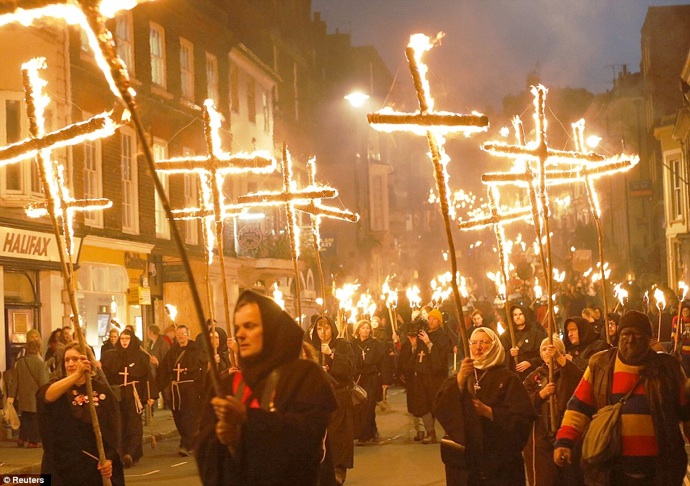
March of the flaming crosses: Lewes residents lined the streets in their hundreds to watch the procession of 17 flaming crosses to represent the Protestant martyrs burnt at the stake in the town in the 16th century
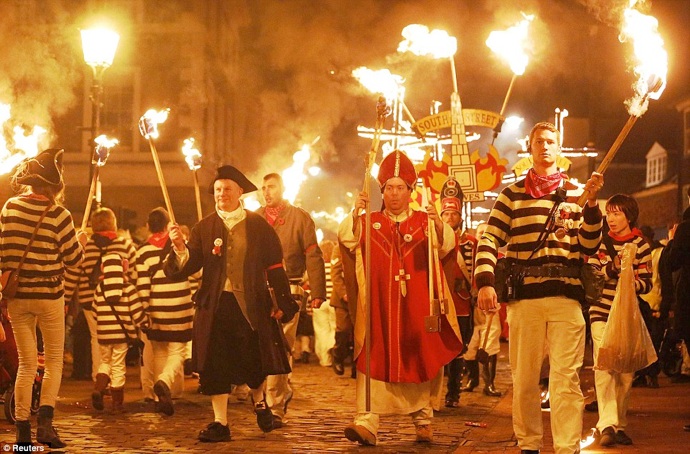
Spectacular show: Participants in the parade hold flaming torches to light up the chilly night air. Forecasters said tonight will be the coldest November 5 for over a decade
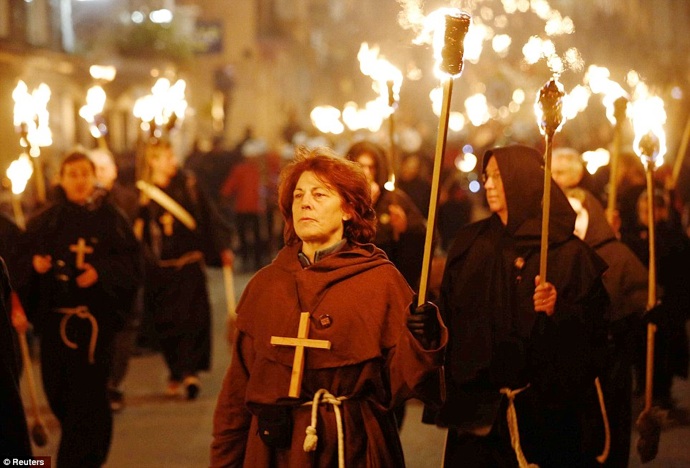
Religious connection: The flame procession in Lewes has its roots in the 16th century. In previous years, 80,000 people have lined the streets to watch as many as 3,000 marchers brandishing torches
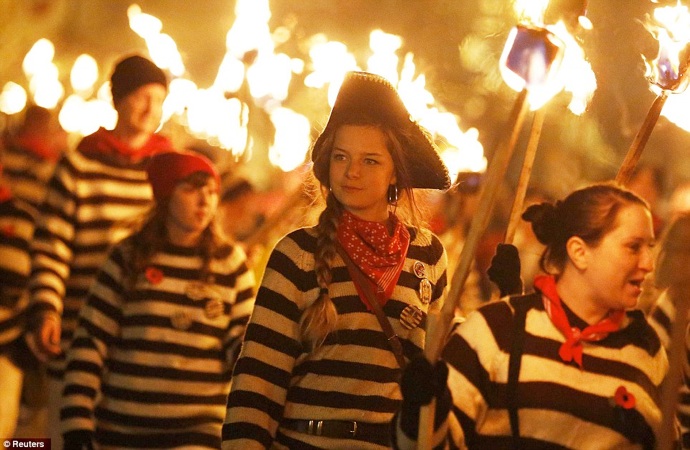
All ages: Young participants in the festivities, which also link to the infamous Guy Fawkes Gunpowder Plot against the Houses of Parliament in 1605
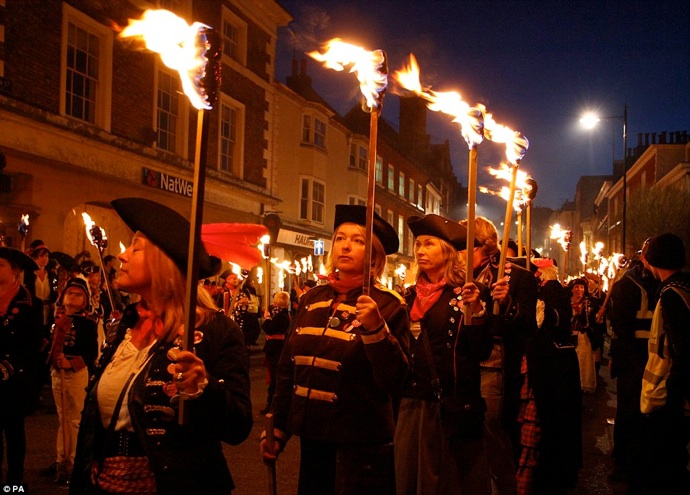
Step back in time: The shops and buildings on the main streets of Lewes may have changed, but this is one annual tradition that holds strong
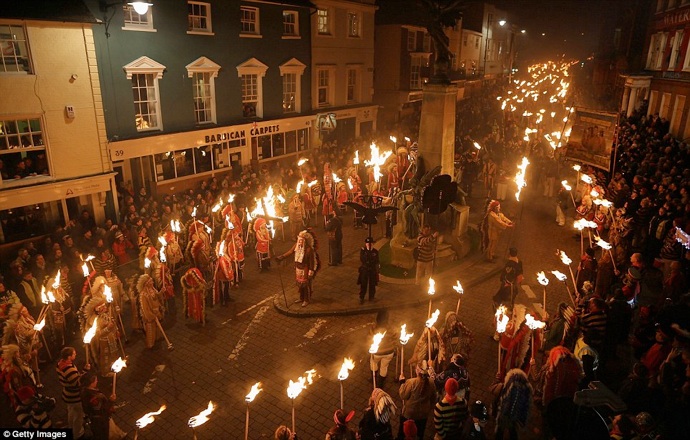
Showpiece: Crowds and marchers gathered around the Lewes war memorial to light crosses. An effigy of Guy Fawkes, who died in 1606 after an unsuccessful attempt to blow up Parliament, is also burnt
The procession, organised annually by six local societies, traces its roots to the 16th century and marks a tumultuous time in English history.
A key part of the parade is seventeen flaming crosses, one for each of the Protestant martyrs burnt at the stake in the town between 1555 and 1557 as part of the Marian Prosecutions.
The purge was initiated by the Roman Catholic monarch Queen Mary, who reigned between 1553 and 1558, and passed strict anti-Protestant legislation against anyone guilty of heresy against the Pope.
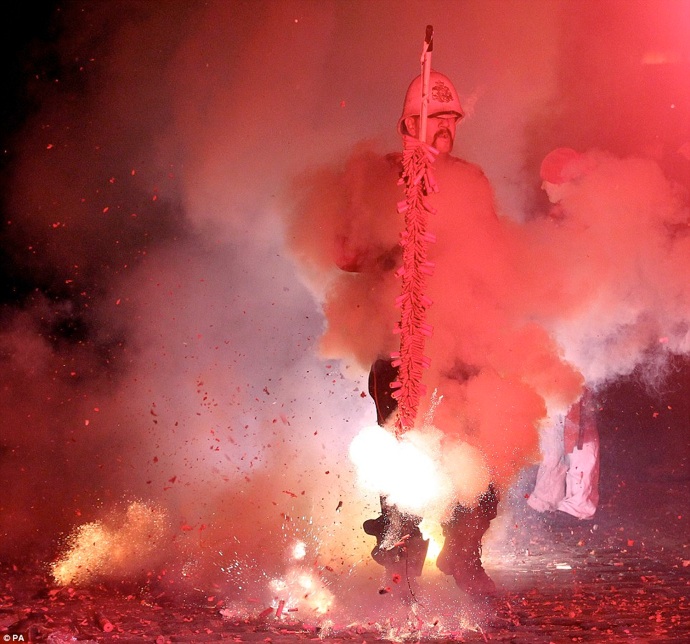
Smoky: This marcher seemed to be creating his own trail of thick red smoke as he made his way through the streets of Lewes

Ritual: Crowds cluster round as dozens of marchers with burning torches perform a ceremony
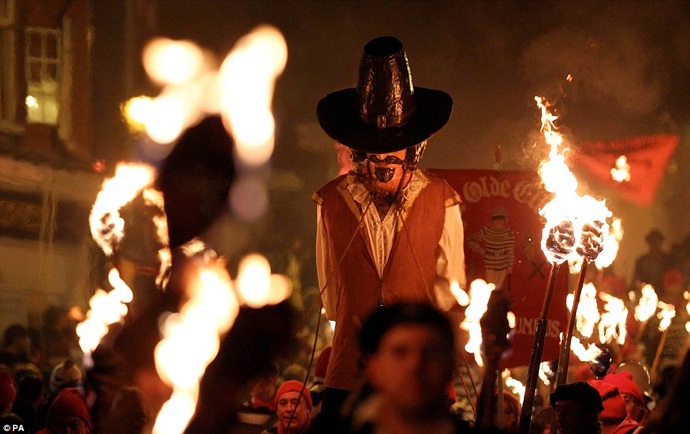
Burn him! The effigy of Guy Fawkes is carried through the streets to be set alight
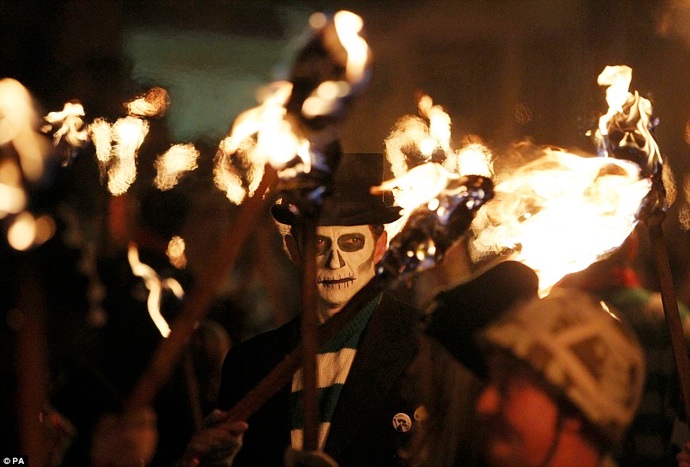
Spooky: Halloween may have been last week but there were still plenty of scary characters in the parade
At least three hundred were martyred in just five years - many meeting a fiery end on the stake and others hung, drawn and quartered.
It is just a part of a number of parades and displays of pyrotechnics in the town - which can attract as many as 80,000 despite the place only having a population of 16,000.
An effigy of Guy Fawkes, who died in 1606 a year after an unsuccessful plot to blow up the Houses of Parliament with Gunpowder.
The Lewes event has previously courted controversy - in 2001, an effigy of Osama Bin Laden attracted national attention, as did the 2003 choice of a gypsy caravan.
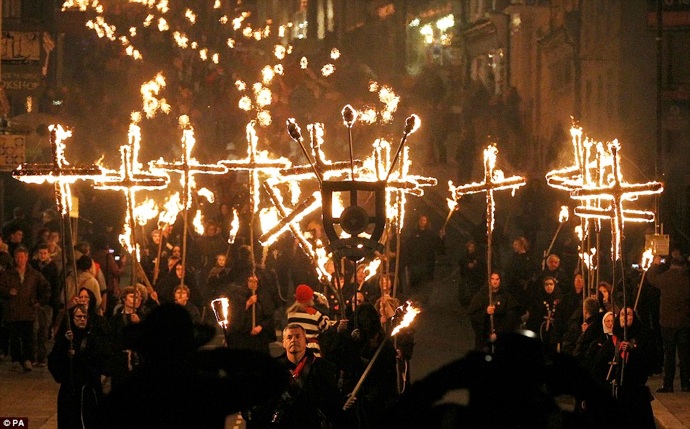
A fiery history: The seventeen flaming crosses in the parade represent the 17 martyrs who were burnt at the stake in Lewes as part of the Marian persecutions against Protestants in the reign of Mary I

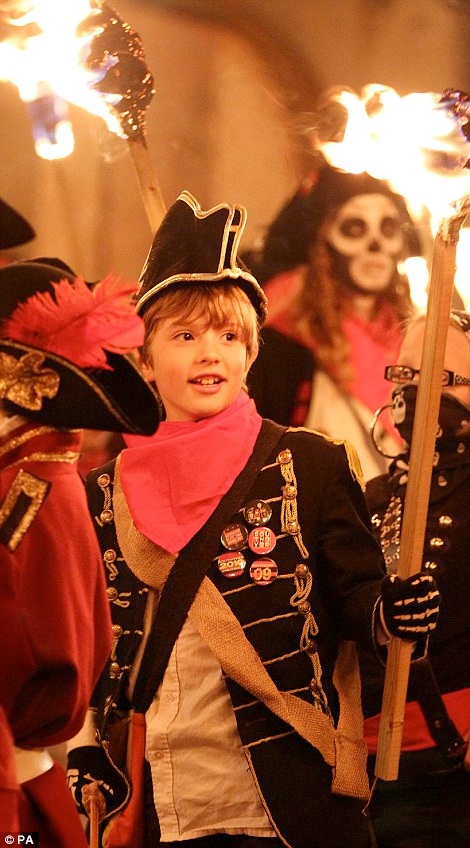
History lesson: The Lewes Bonfire Night celebrations mark, in part, the Marian Persecutions of 1555-1557, a purge of Protestant religious reformers during the reign of Roman Catholic monarch Mary I. Heresy against the Catholic faith was punishable by death, with some burnt at the stake, as in Lewes, and other hung, drawn and quartered
While the flames remained alight in Lewes, others in the country saw their Bonfire Night pyrotechnics washed out by heavy rain.
A number of fireworks displays were cancelled after heavy deluges of rain caused flash flooding in Dorset, Devon, Somerset and Wiltshire the worst affected.
It follows the cancellation of a number of large displays over the weekend, including one in Newham, East London and in the Forest of Dean, Gloucestershire.
In all, the Environment Agency issued seven flood warning in England and Wales on Monday morning, covering areas of the South-West, South-East, East Anglia, the Midlands and Wales.There were also 53 flood alerts in operation .
In Carmarthenshire, nine adults and six children had to be rescued from a caravan park as flood waters rose on Sunday evening.
The Mid and West Wales fire and rescue service used a boat as part of their operation at the Pendine Caravan Park.

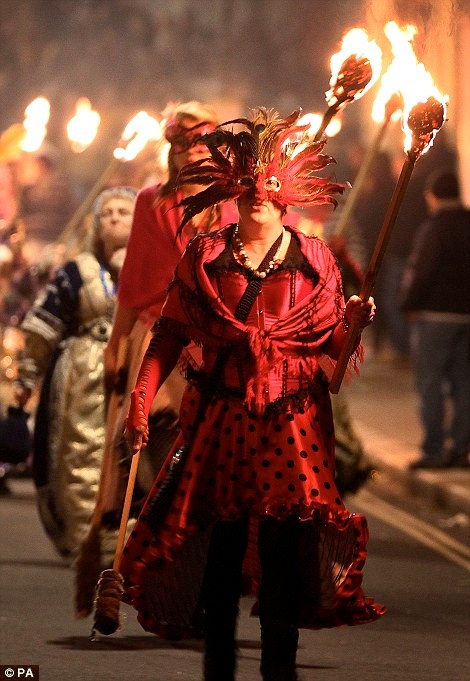
Flaming! Two of the marchers taking part in the annual Bonfire Night celebrations in Lewes, the county town of East Sussex, this evening. Dressed in vivid, blood-red costumes and brandishing burning torches, they are participating in an event which can trace its origins to the Gunpowder Plot of 1605 and the burning of 17 martyrs at the stake in the town in the period 1555-1557
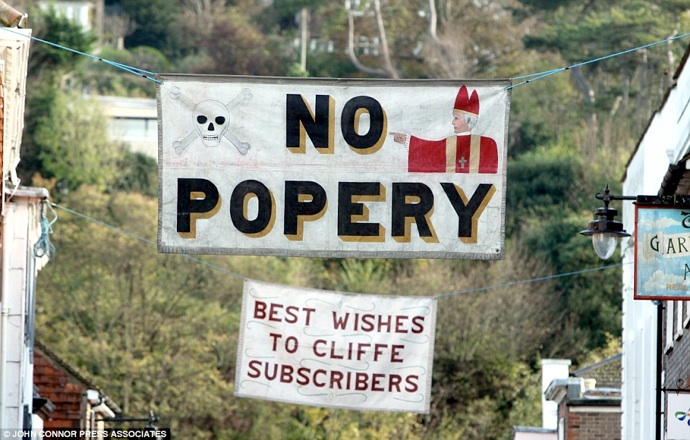
Clear message: Preparations in Lewes have been underway all weekend, with banners hung above the streets followed by the procession
Bournemouth saw the most rainfall in the UK, with 30mm falling in just 24 hours from 5pm on Saturday.
The Dorset town would usually expect to receive 100mm of rain in the entire month of November.
In Essex, the River Roding burst its banks after a severe downpour, while much of the Westcountry saw water levels rise.
But in the Lake District, early risers were treated to a spectacular show of nature as fog shrouded the water and trees and snow glistened on the higher peaks.
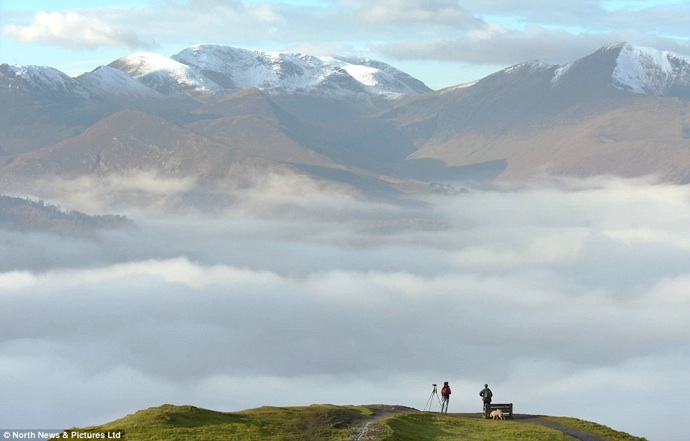
Dwarfed: Walkers on Latrigg early on Monday morning appear so insignificant against this stunning backdrop - though their view of Derwentwater and the other lakes beneath was totally obscured by mist
He was joined by Leona Lewis and boyband Lawson to turn on the 300,000 lightbulbs which make up this year's display on the popular London shopping street.
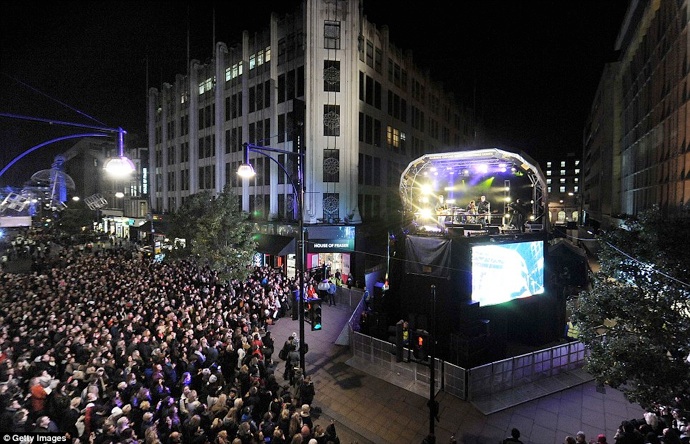
Grand switch-on: Thousands braved freezing conditions to cram Oxford Street as Robbie Williams turned on the Christmas lights on Monday evening

It's that time of year again: A close-up of some of the Christmas lights suspended above Oxford Street
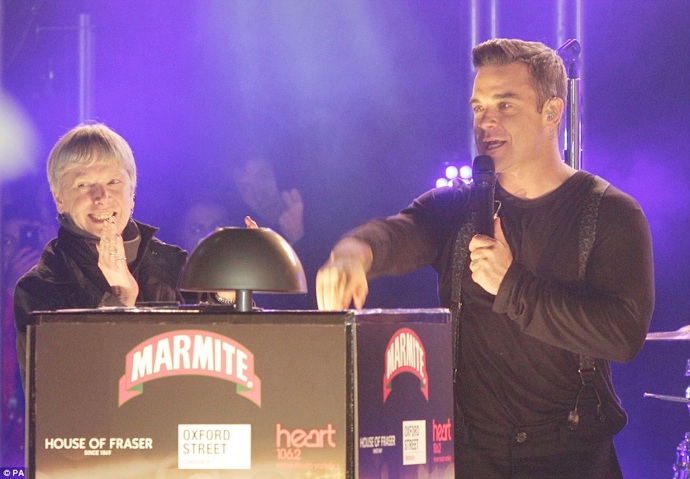
Press the button: Robbie Williams is joined by competition winners to switch on the Oxford Street lights